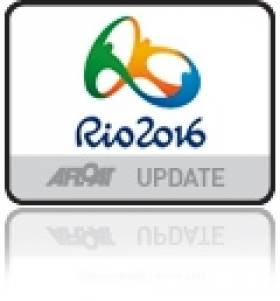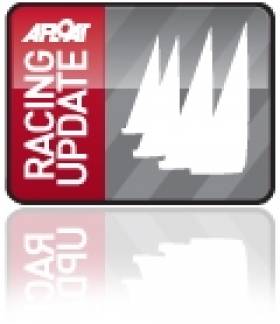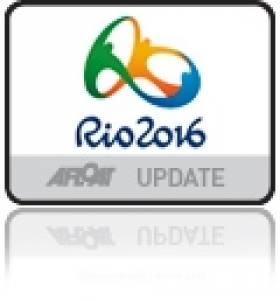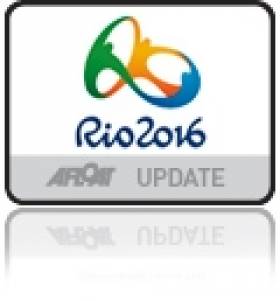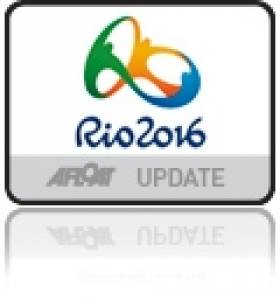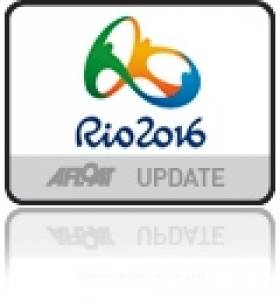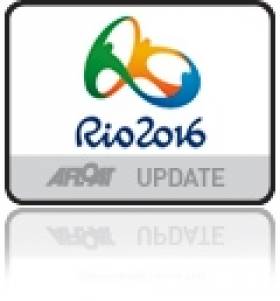Displaying items by tag: Olympic
Irish Sailing Coach Slams 'Disgusting' Rio Olympic Waters
#rio – An Irish Olympic sailing coach has slammed the future Olympic waters of Rio as 'disgusting', according to the Belfast Telegraph. Ian Barker, who won a silver medal for Britain in the Sydney 2000 Olympics' 49er class and now coaches Ireland, said it was the worst he had seen after sailing in 35 countries.
Sailors have expressed disgust at the filthy state of the Brazilian waters in which they will race at the 2016 Olympics, with a former British star describing it as a "sewer".
Barker was coach to Ireland's Tom Fitzpatrick and Frazer Brown in Athens 2004 and more recently to London 2012's Ryan Seaton and Matt McGovern.
He said sailors in training had to stop to disentangle their rudders from rubbish.
"It's a sewer," he told the Telegraph. "It's absolutely disgusting. Something has to be done about it. But you need the political will for these things to happen and at the moment it's not there."
"I've been sailing all over the world for 20 years now, and this is the most polluted place I've ever been," said Allan Norregaard, a Danish bronze medalist in the 2012 London Olympics.
"It's really a shame because it's a beautiful area and city, but the water is so polluted, so dirty and full of garbage."
The Belfast Telegraph has much more on the story including photos of the pollution here.
Weymouth & Portland National Sailing Academy Thrives as Venue for National Sailing Championships
#weymouth – Weymouth and Portland National Sailing Academy has had an outstanding summer one year on from being the host venue for the London 2012 Olympic Games. The Academy has been the chosen venue for many National Championships this summer, thriving in the wake of the Olympics.
The Flying Fifteen National Championships, Topper National Championships, Miracle Nationals, Hurricane National Championships, and also World Championships including the Dragon fleet and the RS Tera Fleet, have all relished the facilities of the Weymouth and Portland National Sailing Academy.
The UK GLOBAL Flying Fifteen National Championships kicked off the summer with their National Championships in July, where 40 boats competed, including visitors from France and Australia. Richard Jones, Flying Fifteen Publicity Officer commented, "The event was a great success and the Flying Fifteen Class thoroughly enjoyed sailing in the wake of Olympic champions."
WPNSA also welcomed one of Britain's most traditional sailing classes, the Miracle Class, for their National Championships in August, with 10 races held over 6 days at the Academy. Sam Meetam, Championship Co-ordinator commented, 'The venue caters well for a traditional class, the facilities are excellent and the choice of bay or sheltered harbour suits well, the venue has an excellent reputation for race management, and they provided perfect set courses for the fleet.'
The RYA Zone Championships took place from the 28th – 29th September. Chris Atherton, Royal Yachting Association, High Performance Manager for the South and South West spoke about the conditions at the Academy. "The sailing inside Portland Harbour offers good, fair racing where the conditions are not too tidal, which is ideal racing for junior sailors for many of whom the 2013 RYA Zone and Country Championships will be their first major event on the RYA Racing circuit."
Many top International Sailing Classes have reserved dates for 2014 National Championships, and key dates for next year at Weymouth will be released in December.
Peter Allam, Chief Executive of WPNSA, is ensuring a sustained approach to attracting important national based events to the Academy on an annual basis, "The Academy has been graced with some very high profile global regattas, which is extremely pleasing. Our on-going ability to host major events for junior and youth sailors is an extremely important role for the Academy. We are very proud to play a part in the development of UK sailing talent and are privileged to witness the progress made as young sailors move from Zone Squads on up through the ranks."
IFDS Disabled Sailing Paralympic World Champions Crowned in Kinsale
#ifds – What a week we have all enjoyed at Kinsale Yacht Club who ran a superb event that was enjoyed by all and sundry who had any connection with the Regatta writes Claire Bateman. It was no easy feat and John Stallard, the Event Director, must be a very happy and relieved man tonight. Sure we had two days when there was no sailing but Kinsale being what it is, the competitors were able to enjoy the wonderful facilities that Kinsale is famous for, not least being known as the gourmet capital of Ireland and set in some of the most glorious scenic areas in the locality. The forecast was uncanny in its accuracy and nobody had any doubts that there was going to be wind to enable a series to be completed and so it was.
Tuesday and Thursday produced unbeatable sailing conditions with sun, wind and hugely exhilarating conditions. Here again Kinsale are blessed with the fact that they have Bullen Bay where they sailed the 2.4Rs where these small boats, looking like miniature 12 metres, were able to sail comfortably without having to endure too much swell.
Today, the last day, produced the first rain and drizzle of the series that pretty well obscured the usual landmarks and even a very large black ship outside the sailing area was barely visible and the conditions must have been especially tough for the gallant sailors in the 2.4mRs. However, the rain and drizzle lifted and in some twelve knots of breeze the Sonars got in three races with the other two fleets getting in two races each.
The most eagerly and tensely awaited race was the final race for the 2.4mR class which was fought out all week between Heiko Kroger from Germany and Guus Bijlard from the Netherlands tied on equal points the top of the fleet and being hotly pursued by Damien Seguin from France. Finally it was Kroger, Billard and Seguin in that order making Heiko Kroger of Germany the 2.4mR World Champion.
In the Sonars it was obvious from the very start that the wily French sailor, Bruno Jourdren was not going to let anyone stand in his way. The French are so into their sailing and are really excellent and very hard to beat. He never allowed anyone to have a look in for the series and no matter how hard Udo Hessels from the Netherlands tried to break the French man's hold he could not succeed and had to settle for second place with the Australian sailor Colin Harrison taking the bronze with Bruno Jourdren is now the Sonar Class World Champion. IFDS President John Twomey of KinsaleYC finished in ninth position.
In the SKUD 18 fleet Alexandra Rickham and Niki Birrell with their unmistakable green kite were the unstoppable winners and took the world title with Italy's Marco Gualandris second and John McRoberts of Canada settling for bronze.
With such a successful event for Kinsale would it be too much to ask that we might see the competition return there at some future date?
#49er – A credible top ten performance at Kiel week this week for Northern Ireland's 49er pairing Ryan Seaton and Matt McGovern marks another auspicious step on the ladder for Rio 2016, given this is only the dinghy pairs second regatta since returning from London 2012.
This week's German result follows Sail for Gold victory in Weymouth a fortnight ago and positions the Ballyholme duo well for this month's 49er Europeans, the main target of their summer campaign. The pair finished seventh overall in a Kiel fleet of 51–boats, recovering from some mid-fleet performances earlier in the series.
Belfast team mate James Espey did not fare as well in the mens Laser division finishing 60th out of 92 starters.
Tiffany Brien, also from Belfast lough, now teamed with Dubliner Saskia Tidey were 12th from 15 in the brand new 49er fx women's Olympic class. This pair are also heading for a class European championships.
Full results in each class of Irish interest is downloadable below
Irish 49er Pairing in First Place at Sail for Gold Regatta
#sailforgold – London 2012 49er Irish pairing Ryan Seaton and Matt McGovern have made a great return to the Olympic circuit this week at Sail for Gold Regatta in Weymouth. The Irish 49er team are beating some heavyweight competitors and holding first place by a margin of six points.
In a complete change of conditions in Weymouth Bay there was an average of 20–knots blowing across Portland Harbour largely suiting the Irish fleet on the Dorset coast.
A strong performance from Annalise Murphy moves her into the top five overall with two more fleet races to go but it was the stand out performance of China's Lijia Xu that has impressed many at the former Olympic venue. The Olympic Gold medallist now has a ten point margin over countrywoman Dongshuang Zhang.
In the best day so far for 49erfx campaigners Tiffany Brien and Saskia Tidey they secured top 5 results in today's stronger conditions. They move up two places to sixth overall.
Laser sailor James Espey remains in the middle of the Laser fleet following four races.
Irish youth laser radial sailors Séafra Guilfoyle, Finn Lynch, Fionn Leyden and Cian Byrne are still holding on to their top ten spots.
#dlr2013 – Annalise Murphy shares the lead with Britain's Alison Young after eight races in the Laser Radial class which means today is an action packed last day of finals racing in the Delta Lloyd regatta in Holland before the top six medal race tomorrow.
Murphy told supporters last night: 'Luckily I didn't have to race during the hailstones today! Managed a 3rd and a 2nd followed by a not so hot 16th'
The Dun Laoghaire sailor will be pushing to ensure a top position for the medal race cut in a forecast of medium winds on the Ijsselmeer. It looks lke a tricky day for the sailors with a shallow low pressure tracking south over the North Sea providing a decreasing and backing wind from South south west to east. And it's raining!
More from David O'Brien in the Irish Times this morning here.
The Dutch teams made the most of the day at the Delta Lloyd Regatta in Medemblik. At the end of the third day of racing, there is a Dutch boat in the top three of all classes at the exception of the 49er were Holland is not represented.
Pieter Jan Postma in the Finn and the Sonar team of Udo Essel took it all in the three races sailed in freezing conditions. They are now in the lead.
PJ Postma who enjoyed the breeze yesterday was pleased with his day: "It finally all came together! The feeling is right as well as the fitness and the tactics. I am pleased with the way I go and it surely gives me confidence for the regattas ahead." Early leader Andrew Mills (GBR) collected a disqualification at the start and drops to the seventh position overall.
Paralympic champions Udo Essel, Mischa Rossens and Marel van de Veen proved today with three victories in the Sonar that they trully deserve their Gold medal. "We took a long break after London, so it is great to see that we are still up to it. It gives confidence for the future."
The Dutch sailors are conserving their lead in the Nacra and the RS:X Men.
Mandy Mulder and Thijs Visser (NED) increase their lead after two bullets in the Nacra. The french and Swedish teams have close results with Moana Vaireaux and Manon Audinet (FRA) in second overall.
Dorian van Rijsselberge (NED) in the RS:X class is flying away with a win and two second places. Przemyslaw Miarczynski (POL) and Julien Bontemps (FRA) remains second and third.
The result is very tight in the RS:X women, with the top five within five points. Hei Man Hayley Victoria Chan (HKG) conserves a narrow lead from Moana Delle (GER). Third place is taken by Dutch windsurfer Lilian de Geus.
The Danish are again proving their domination in the skiff with Jonas Warrer and Peter Lang enjoying a 14 points lead over French Julien D'ortoli and Noe Delpech in the 49er.
Palma SWC winners, Ida Marie Baad Nielsen and Marie Olsen (DEN) take a narrow two points lead in the FX over Germans Tina Lutz and Susan Beucke. Early leaders Annemiek Bekkering and Claire Blom (NED) are now in third position.
The dual at the top continues between Laser World number 1, Australian Tom Burton and Palma winner Andy Maloney (NZL). They place first and second in the first day of the Laser final with the top 25 boats. In the women, Alison Young (GBR) shares the lead on equal points with Irish Annalise Murphy.
World #1 Matt Belcher and Will Ryan (AUS) are back in the lead in the 470 class after two wins and a third place. In the women, Jo Aleh and Polly Powrie (NZL) are increasing their lead after top two places and a win. The other two races were taken by Dutch team of Afrodite Kyranakou and Anneloes van Veen (NED) who climb in third position.
It is a close score in the 2.4 after three more races sailed in freezing conditions. The top three win a race each with Megan Pascoe (GBR) leading from Barend Kol (NED) and Helena Lucas (GBR).
Tomorrow will see the last day of the final stage and the last chances to qualify for the top 8 in the skiffs and the medal races scheduled for Friday night, and the top six in the other Olympic classes who will race their medal race on Saturday.
The forecast on Friday is from medium winds.
Annalise Goes for Gold at Italy's Eurosaf Olympic Week
Annalise Murphy finished four points clear at the top of the leaderboard at Italian Olympic week yesterday and will be today's six–boat medal race favourite at the inaugural Eurosaf sailing cup on Lake Garda. Strong local 'Ora' winds are blowing on the lake this morning suiting the Irish sailor.
The 23-year-old Dun Laoghaire single–hander counts a string of five first places in her 47-boat fleet to lead Croatian sailor Tina Mihelic. Third is Finn Tuula Tenkanen.
Annalise just missed the podium in last year's Games. The Croatian came 17th in London and Tenkanen two places in front of sister Heidi who came 5th.
Annalise hit form on Wednesday afternoon bouncing back from a ninth in race one to score a first and second with five more wins following, stamping her heavy air authority on the fleet.
She ended the qualifying rounds however with a 29 and 7 describing yesterday 'as a pretty crazy day' on the lake with winds blowing from zero to 20-knots.
This 47-boat affair is not at World cup level but it is nevertheless a strong fleet and one where the National Yacht Club single-hander is proving herself after crashing out of the gold fleet of the World Cup in Hyères a fortnight ago.
The new Eurosaf series concept has been designed to complement ISAF's world cup and this week is its first outing with some new style competition formats.
live streaming of the medal race will be on Afloat.ie when available from local broadcasters
Laser Radial Finalists
1)IRL Murphy
2)CRO Mihelic
3)FIN Tenkanen T.
4)BLR Drozdovskaya
5)FIN Tenkanen H.
6)TUR Donertas
Top ten qualifying round results below:
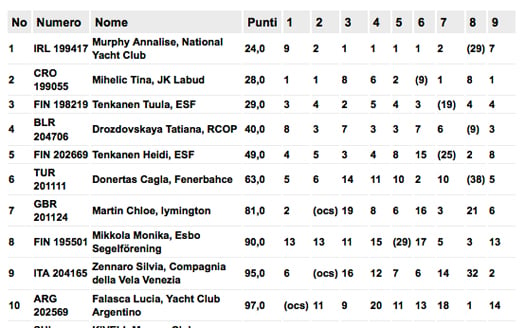
What Makes an Elite Sailor? Annalise's Coach Speaks
Muscle memory, tuning in to the wind and the waves, a rigorous daily schedule plus a pool of upcoming youth sailing talent is discussed by Annalise Murphy's coach Rory Fitzpatrick in this three minute vid aimed at promoting Irish Sports Council initiatives for Ireland's Olympic sailing future.
Claudine Murphy & Andrea Brewster. 49er FX Skiff Campaigners
Annalise Murphy's older sister Claudine has announced plans to join Annalise on Rio's Guanabara Bay in the latest Irish women's skiff campaign.
Claudine has teamed up with former British trialist Andrea Brewster in a bid for the Irish 49erfx slot against Tiffany Brien and Saskia Tidey also seeking a place in the official squad and a place in this new class for the Rio games.
Here Claudine gives some background on her campaign:
I met Andrea for the first time at the 2004 Laser Radial Europeans in Bangor. Andrea has been sailing the laser full time since then and was Annalise's training partner for the London Games. Annalise had joked about us teaming up in the FX for 2016 but we did not look into it seriously until February of this year. Andrea has dual citizenship so decided to use this to team up with me and start a campaign. She has been in the top 30 in the world consistently from 2005 to 2012 in the laser radial, her most notable result being a bronze medal at the 2008 Laser Radial Worlds. We both decided we had similar ambitions in our sailing and are at a position to go full time to give it a proper go.
We intend on debuting at Sail for Gold in Weymouth where we have been training for the past five weeks. Portland harbour is ideal for learning how to skiff sail as it is large and relatively obstacle free! We then plan on attending the next European cup event in Kiel followed by the Europeans in Denmark. There is then quite a large gap until the worlds in Marseille in mid September.
Our short term goals are to make ISC funding so we can progress forward into 2014 with support. Our main goal for now is to learn to control the boat in all conditions. Skiff sailing in a breeze is more extreme than any kiteboarding or skiing I have done in my last year of travelling! We have had some very comical scenarios in this learning process which makes the terror and injuries sustained worthwhile! I am also very glad of the fitness I worked on last year when I rowed for DULBC while doing my Masters in Trinity. Skiff crewing is very physical so my fitness regime has increased dramatically in the past few months. Long term it will be important to qualify the nation in Santandar next September as it will be much more difficult to do so with the new continent divisions in nation places for 2016.
I think the difficult thing about sailing a double handed boat is finding somebody you can have a successful working partnership with. But I am delighted to have found somebody to sail with who is so talented and dedicated to Olympic sailing as Andrea is. We are basing ourselves in DunLaoghaire from now so between ourselves and Annalise in her moth we will give the pier onlookers lots of entertainment this summer!
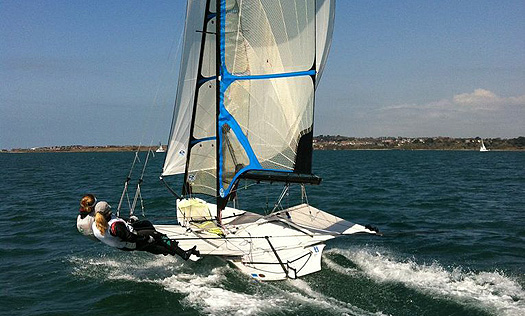
Claudine and Andrea in flying form in a training session in Weymouth. Photo:Tom Peel
Below Andrea also gives some background to the new campaign:
Towards the end of last year I made the decision to sail the 49erFX which is the new Women's Skiff Class in for Rio 2016. The FX is by far the most exciting class ever to be brought in for Women to sail at the Olympics and I could not resist the opportunity to sail full time in such a fantastic boat. So I bought an FX and with the help of some good friends I began learning to try and master the art of skiff sailing.
The difficulty I have found about learning to sail the FX is that as a beginner its fairly risky to go sailing in anything much above 15 knots so that immediately reduced the amount of days I was able to train. Between October and March I think I managed to do about 3 weeks of sailing in total as either there was too much wind or I was unable to find anyone to sail with. I started looking for someone to team up with to get a campaign underway back in September and despite trying out with some very good sailors I was unable to find anyone in a position to be able to sail full time with me. After such a slow start and still no full time crew I was beginning to wonder if I was realistically going to be able to continue campaigning. I thought back to conversations I'd had with my great friend and training partner for the last few years in the Radial, Annalise Murphy from Ireland. We used to joke that I should become Irish and sail a skiff with Annalise's sister Claudine for 2016. At the time it sounded pretty far fetched but nearly 6 months after buying my FX and no further on with a campaign I realised that this might be the only opportunity I might have. My Mum's side of the family are all of Irish descent, so I knew that I could be eligible to sail for Ireland. After talking it through with Claudine and discovering that she was also at a cross roads in life which meant she could go full time if sailing if she wanted, we decided to try out together in the FX. We discussed things in great detail and I was pleased to learn that we both shared the same aspirations for the campaign and from there we decided to seize the opportunity and go for it!
So I am now pleased to officially announce that Claudine Murphy and I are campaigning for Rio 2016 sailing for Ireland. We are only a few weeks into our training so far but as you can see from the picture we are throwing ourselves into it!
I am very grateful for all the support and encouragement I have received so far from everyone about my decision to switch to sail for Ireland. I have many fond and proud memories of my time representing Britain and I am now looking forward to this next exciting chapter in my life!
#isafworldcup – Annalise Murphy won both her races at the ISAF world Cup today but she is still counting the cost of disappointment in the qualifying rounds that has dropped her into the Silver fleet of the Laser Radial fleet.'I won both races today. Wish I was in gold but really makes me realise the importance of getting it right in qualifying' she said on coming ashore.
In the mens Laser fleet Belfast's James Espey discarded 44th leave to him 28th overall in the Laser Gold fleet.
The mistral at ISAF Sailing World Cup Hyères kicked in on the third day of racing in the South of France as the final series got underway, pitting the top sailors against one another.
After two days of tricky breeze a fresh 17-20 knot easterly breeze was welcomed by the sailors as racing ramped up.
Making the most of the conditions in the Nacra 17 was Sweden's Tim Shuwalow and Hanna Klinga who moved into pole position whilst France's Audrey Ogereau and Matthieu Vandame were in fine form taking two bullets to progress up the leader board.
Carrying forward a non discardable fifth place from the qualification series the Swedes notched up a third, second and an eighth, discarding the latter, to open up a three point advantage over Switzerland's Matias Buhler and Nathalie Brugger (SUI).
Shuwalow and Klinga teamed up three months ago and at ISAF Sailing World Cup Palma they finished sixth and Shuwalow is under no illusions that they are the finished product at such an early stage, "We're still developing and learning a lot each day and have a long way to go yet but it's proving good so far," said Shuwalow. "We try and keep it fun because obviously there are stressful moments and that's the way it always will be but she's new to the catamarans and enjoying it and I just really love the Nacra 17."
Two days of final series racing and two Medal Races follow and the Swedes believe a podium could be in sight, "If we continue sailing consistently and up there then we're in with a chance but there are many good teams and some of them are probably yet to find form this week and it will get tougher as we get towards the end no doubt."
Whilst the Swedish partnership proved consistent, stealing the day was France's Ogereau and Vandame as the pair picked up double race wins and an eighth. Carrying a 21st forward they have progressed nicely to eighth overall and just 11 points off the leaders.
"On the two races we won we had good starts and good speed upwind," said Ogereau. "It was busy on the start line and good starts don't always get you at the front but in these races we knew that the left was better so we got first.
"In our first win we were 20 metres ahead and a bigger distance of 150 metres in the second so we were happy with our speed in these races."
Swiss pair of Buhler and Brugger won the first race of the day and posted an impressive third and ninth to sit second whilst rounding off the top three is Billy Besson and Marie Riou (FRA).
Despite an OCS in the second race of the day Dylan Fletcher and Alain Sign (GBR) have taken the lead in the 49er. Carrying a third place forward they recorded a sixth and a fourth but will have to tread carefully for the remainder of the final series following an OCS.
Making the biggest climb up the leader board is Spain's Carlos and Anton Paz. The Spanish brothers flew out the traps taking a bullet and a second in the gold fleet before a 13th in the last race of the day. The result moves them from 14th to fifth. "For us our first two races were really good with a first and a second," said Carlos. "The last one was completely opposite after a change in the wind but overall we're happy with our day. Our 13th isn't a bad result for a discard so we will try to push and be in the final eight."
ISAF Sailing World Cup Palma gold medallists Erik Heil and Thomas Ploessel (GER) are just one point behind Fletcher and Sign whilst France's Julien D'ortoli and Noe Delpech sit third.
In the 49erFX Charlotte Dobson and Mary Rook (GBR) are coming together nicely after racing with different team-mates at ISAF Sailing World Cup Palma. Dobson finished fifth with Sophie Ainsworth whilst Rook came 22nd with Kate Macgregor. Two race wins in Hyères has moved them into top spot ahead of World #2 Alex Maloney and Molly Meech (NZL), who took the days other race win, and World #1 Martine Grael and Kahena Kunze (BRA).
"We're not really too focussed on the results," said Dobson, "although you're a competitive person so they are pretty much always on your mind – even though you say to your coach they're not."
With limited skiff racing experience the British team are mixing the 49erFX racers up at the early stages of the quadrennial to find the right formula and Dobson is seeing the progression first hand, "The learning curve is literally vertical, every day is a learning day and that's what's making it really rewarding at the moment. You can really see the steps you're making forward every single day."
Ivan Pastor (ESP) held onto his lead in the Men's RS:X but French youngster Louis Giard was the stand out performer on the race track winning the first of the day and coming second in the other. Carrying forward a fourth Giard, who finished third at the 2011 ISAF Youth Worlds, moves up to second overall and was a cheerful sailor after racing, "I was behind the Polish sailor but he was OCS so that was the win for me. This is my first win here and I'm really happy."
In the Women's RS:X Charline Picon (FRA) and Bryony Shaw (GBR) hold a joint lead following solid days on the water. Shaw took the first race win whilst ISAF Sailing World Cup Palma victor Flavia Tartaglini (ITA) took the second to move to third overall.
Tonci Stipanovic (CRO) leads Brazil's Bruno Fontes and Robert Scheidt in the Laser after a race win and a discarded BFD. Australia's Matt Wearn took the days other bullet but carrying forward a 44th he only moves up to 25th overall.
Holding her Laser Radial advantage on the first day of the final series is Tuula Tenkanen (FIN). A third and a sixth enabled her to maintain her two point advantage over the chasing pack. Taking the day's race wins was Canada's Isabella Bertold, who lays fifth overall, and Great Britain's Alison Young, sitting pretty in fourth.
Mat Belcher and Will Ryan (AUS) were back on top form in the Men's 470 taking double bullets to jump up two places to second. Luke Patience and Joe Glanfield (GBR) hold the lead by two points but discard a 24th.
Fernanda Oliveira and Ana Barbachan (BRA) remain firmly at the top of the Women's 470 leader board and have an eight point advantage over Anne Haeger and Briana Provancha (USA).
Pieter-Jan Postma (NED) has taken first overall in the Finn class and is one point ahead of Giles Scott (GBR) and Vasilij Zbogar (SLO).
In the 2.4mR Heiko Kroger (GER) opened up a seven point lead over Megan Pascoe (GBR) and in the Sonar Aleksander Wang-Hansen, Marie Solberg and Per Eugen Kristiansen (NOR) and Bruno Jourdren, Eric Flageul and Nicolas Vimont-Vicary (FRA) share the lead.
Racing resumes on Thursday 25 April at 11:00 local time.



























